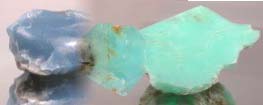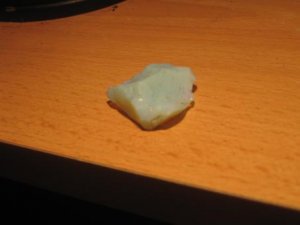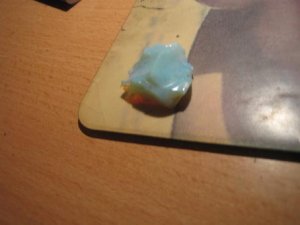You are using an out of date browser. It may not display this or other websites correctly.
You should upgrade or use an alternative browser.
You should upgrade or use an alternative browser.
picture of..?
- Thread starter pavan
- Start date
- Status
- Not open for further replies. Please create a new topic or request for this thread to be opened.
- Joined
- Aug 29, 2003
- Messages
- 15,808
Looks like opal allright...
The second photo shows a white mass without much olor play: is it so in person ? That would be the look of dehidrated opal in the pic.
This article calls this "white opal".

The second photo shows a white mass without much olor play: is it so in person ? That would be the look of dehidrated opal in the pic.
This article calls this "white opal".

- Joined
- Feb 17, 2004
- Messages
- 1,104
Date: 2/28/2005 6:36:30 PM
Author: valeria101
Looks like opal allright...
That would be the look of dehidrated opal in the pic.
With all due respect this is normal vein opal, probably from Coober Pedy, Australia. Judging from the small amount of color play in the image it has the appearance of white base "potch and color." I have a couple of pieces that look exactly like it sitting on my cutting machine right now.
Richard M.
- Joined
- Aug 29, 2003
- Messages
- 15,808
Thanks for the call back to realityDate: 2/28/2005 6:56:24 PM
Author: Richard M.
With all due respect this is normal vein opal, probably from Coober Pedy, Australia. Judging from the small amount of color play in the image it has the appearance of white base ''potch and color.'' I have a couple of pieces that look exactly like it sitting on my cutting machine right now.
Richard M.

''Guess the piece reminded me of Spanish opal... but that''s so unlikely. What was I thinking ?

- Joined
- Feb 17, 2004
- Messages
- 1,104
Hi Ana,
Mexican opal I''ve heard of ... but Spanish? Please educate me. The only sources of precious opal in Europe I know are the ancient mines at Czernowitza, between Kaschau and Eperies in Hungary.
I''m pretty sure they are no longer producing but this was probably the gem opal known to the Romans, described by Pliny the Elder. Common opal (without play of color) is abundant around the world, of course, and is often fashioned into various decorative forms including jewelry stones.
Richard M.
Mexican opal I''ve heard of ... but Spanish? Please educate me. The only sources of precious opal in Europe I know are the ancient mines at Czernowitza, between Kaschau and Eperies in Hungary.
I''m pretty sure they are no longer producing but this was probably the gem opal known to the Romans, described by Pliny the Elder. Common opal (without play of color) is abundant around the world, of course, and is often fashioned into various decorative forms including jewelry stones.
Richard M.
- Joined
- Feb 17, 2004
- Messages
- 1,104
- Joined
- Aug 29, 2003
- Messages
- 15,808
It is not precious - just white opal with little if any play of color. More of a local rock houd curiosity.Date: 2/28/2005 7:31:41 PM
Author: Richard M.
Mexican opal I''ve heard of ... but Spanish?
- Joined
- Feb 17, 2004
- Messages
- 1,104
While on the topic of "common" opal (without play of color) some types have strong, appealing color and other qualities that make them useful for lapidary projects. These are pieces I picked up in Tucson for carving. The blue-grey material is from the Idaho/Oregon, USA border region and is very translucent against the light.
The middle piece is blue opal from Peru. Since it is mined in a copper producing region the blue tint probably is derives from copper. It can be very beautiful but is often quite fractured.
On the right is a very rare material. It is from Macedonia and takes its blue-green color from nickel, just like chrysoprase. A very small amount was produced in 1992 and I was fortunate to find a dealer who had a nice selection.
Richard M.

The middle piece is blue opal from Peru. Since it is mined in a copper producing region the blue tint probably is derives from copper. It can be very beautiful but is often quite fractured.
On the right is a very rare material. It is from Macedonia and takes its blue-green color from nickel, just like chrysoprase. A very small amount was produced in 1992 and I was fortunate to find a dealer who had a nice selection.
Richard M.

- Joined
- Feb 17, 2004
- Messages
- 1,104
Date: 3/1/2005 6:24:24 AM
Author: pavan
if it is of any interest this stone was found in sweden not a normal place for opals is it?
Not to my knowledge. When I think of gems from Sweden I''m more likely to think of river pearls and Baltic amber. Do you know the location where it was mined?
no i don''t.
my best friends father tried to have it certified and valued at different jewelery shops here
in sweden, they confirmed itis a opal but they said they never seen anything like it in colour
unfortunaly my friends father drowned a couple of days ago he called us 15 min before and said
we must talk.
thats why i am curious about it..
this is a 100% true story
and like i said in my first post the stone was found in a shrine together with some gold coins from early
1600 and a neclace made out of hair with a amulett
if it is of interest i can try to take better pictures
my best friends father tried to have it certified and valued at different jewelery shops here
in sweden, they confirmed itis a opal but they said they never seen anything like it in colour
unfortunaly my friends father drowned a couple of days ago he called us 15 min before and said
we must talk.
thats why i am curious about it..
this is a 100% true story
and like i said in my first post the stone was found in a shrine together with some gold coins from early
1600 and a neclace made out of hair with a amulett
if it is of interest i can try to take better pictures
widget
Ideal_Rock
- Joined
- Nov 12, 2004
- Messages
- 4,255
Ymanda
Rough_Rock
- Joined
- Jan 25, 2005
- Messages
- 30
Ok guys,
After a quick look to that opal i would say that it is for sure "Noble Opal". Now about the origin, blue milky opals could be volcanic or from sedimentary origin.
If that opal is very porous (try to put your tong on it) it could be volcanic (Rhyolite matrix from volcanic tuff, dust concretion in eggs called "tunder eggs").
The fact it as been found in Sweden makes me think of Hungary as a possible origin. But it could have come by boat from south America : Brazil (sedimatary origin) or Mexique (volcanique). Well we can dream of piracy, battles, treasures... But i don''t think that stone is very valuable

In conclusion, it''s very difficult to give an opinion based on a picture because opals from the same deposit can show a wilde range of colors, appearance, sometimes in the same stone. The first step should be to analyse it with Raman (non destructive method) or X-Ray diffraction (destructive) to know at least if it comes from an Volcanic or sedimentary deposit (opals C, CT or A : trydimite, Cristobalite, Amorpheous).
Here is an exemple of multiple colors in the same opal (orange part due to iron impurities).

Ethiopian opal with 3 parts : White milky opal called "opal gelly" (porous), Fire opal (not porous) and colorless opal at the top (which correspond to the center of this nodule that i broke to make analysis)
In the same deposit you can find Blue noble opals crystal quality (not milky) with "contra-luz" effect... so the color as nothing to do with the geographical or geological origin. In corundums you can have an idea if you are used to them, but with opals i would not take the risk, especially from a picture...
I invite you to have a look on my personnal website where you can find my work (PDF file) on Ethiopian opals. It is in french, but you will at least see an example off all the varieties of color you can find in the same deposit:
http://gemme.la.rca.free.fr/DUG_Opales_d-Ethiopie.htm
(old work that can still be usefull as an introduction to opal classification)
After a quick look to that opal i would say that it is for sure "Noble Opal". Now about the origin, blue milky opals could be volcanic or from sedimentary origin.
If that opal is very porous (try to put your tong on it) it could be volcanic (Rhyolite matrix from volcanic tuff, dust concretion in eggs called "tunder eggs").
The fact it as been found in Sweden makes me think of Hungary as a possible origin. But it could have come by boat from south America : Brazil (sedimatary origin) or Mexique (volcanique). Well we can dream of piracy, battles, treasures... But i don''t think that stone is very valuable

In conclusion, it''s very difficult to give an opinion based on a picture because opals from the same deposit can show a wilde range of colors, appearance, sometimes in the same stone. The first step should be to analyse it with Raman (non destructive method) or X-Ray diffraction (destructive) to know at least if it comes from an Volcanic or sedimentary deposit (opals C, CT or A : trydimite, Cristobalite, Amorpheous).
Here is an exemple of multiple colors in the same opal (orange part due to iron impurities).

Ethiopian opal with 3 parts : White milky opal called "opal gelly" (porous), Fire opal (not porous) and colorless opal at the top (which correspond to the center of this nodule that i broke to make analysis)
In the same deposit you can find Blue noble opals crystal quality (not milky) with "contra-luz" effect... so the color as nothing to do with the geographical or geological origin. In corundums you can have an idea if you are used to them, but with opals i would not take the risk, especially from a picture...
I invite you to have a look on my personnal website where you can find my work (PDF file) on Ethiopian opals. It is in french, but you will at least see an example off all the varieties of color you can find in the same deposit:
http://gemme.la.rca.free.fr/DUG_Opales_d-Ethiopie.htm
(old work that can still be usefull as an introduction to opal classification)
- Status
- Not open for further replies. Please create a new topic or request for this thread to be opened.
Share:
Featured Topics
Past, Present, Future: The Meaning of Three-Stone Engagement Rings
Past, Present, Future: The Meaning of Three-Stone Engagement Rings - 04/14






300x240.png)